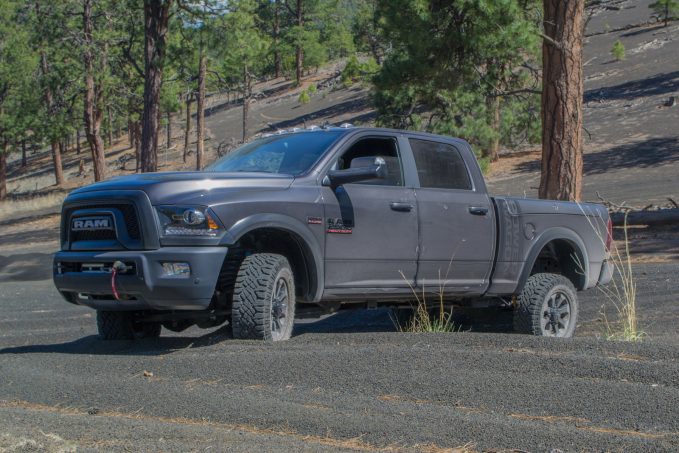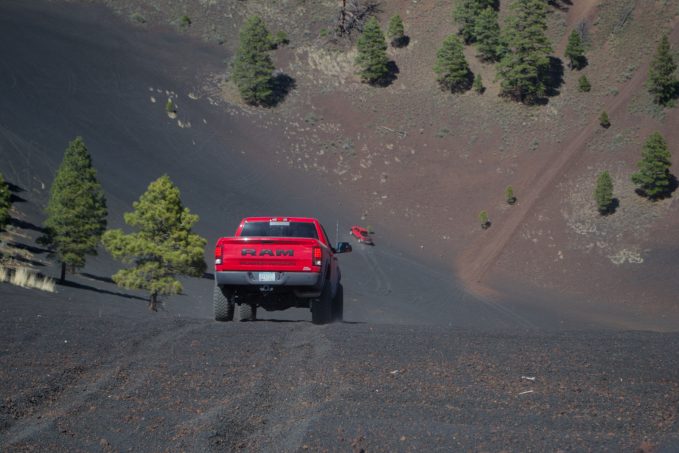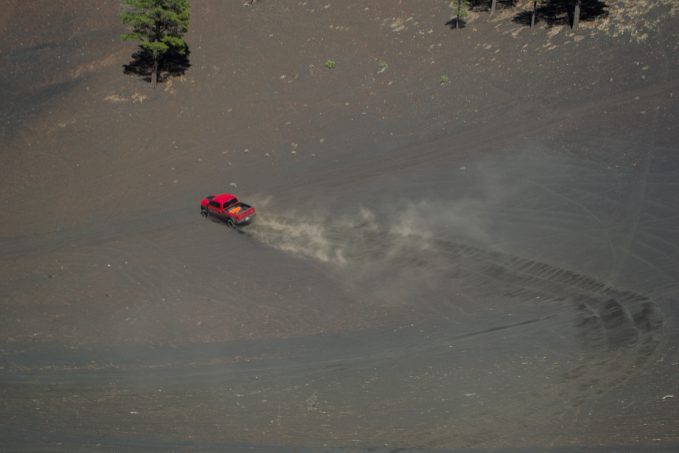Media drive programs are, for the most part, carefully crafted events designed to showcase a vehicle’s abilities.
Tons of time and energy is invested in planning routes and automotive journalists are rarely encouraged to deviate from what’s been plotted. There are, of course, a few exceptions. And rumor began to swirl on a recent Ram Trucks event that one such exception could come to fruition.
After spending a day — and a successful one, I might add — chasing a pack of 2017 Ram 2500 Power Wagons around the Arizona desert behind the wheel of a Ram 1500 Rebel, I had reluctantly resigned myself to the fact that our off-road escapades were all but over. And then suddenly a glimmer of hope emerged. Buzz began to grow about a last-minute trip to Cinder Hills, a sprawling 13,500-acre complex of trails in the wilderness outside Flagstaff, Ariz.
Such an unplanned excursion is usually a tough sell to the staff in charge of organizing these events. After all, these are the folks who are responsible for the safety of both the attendees and the vehicles they’re driving; an unplanned excursion could put both at risk. It could also be a pretty big PR disaster if something were to go wrong, which could be anything from a truck getting stuck to someone getting injured or worse.
Thinking I was going to have to turn the screws on the Ram Trucks team if we had any chance at a second day of off-road adventure, I was pleasantly surprised to find absolutely no resistance to the idea. Better yet, we were to be joined by Ram’s brand manager in charge of HD trucks, Jeff Johnson, and its media relations guru, Nick Cappa. Not only would the two make for great company, but they’d both be great shields in the event things went awry.
Cinders and Saints
With our herd from the previous day thinned, we were joined by off-road instructor extraordinaire Nena Barlow, who graciously agreed to lead us once again into the grueling-yet-rewarding Arizona desert. The short drive northwest of Flagstaff included a quick stop at a gas station for us to grab some snacks and air down our trucks’ tires — in this case, from 65 psi to about 35 psi. As we would soon find out, the loose-pack cinder, a type of rock created from cooled lava, meant traction would be at a premium. A wider footprint, then, would serve us well in the long run.
ALSO SEE: Can a Ram Rebel Keep up With a Power Wagon in the Arizona Desert?
In the interest of full disclosure, Ram has been to this neck of the woods before. In fact, it was just a couple of years ago that the brand brought a group of journalists to Cinder Hills for the launch of the Ram 1500 Rebel. That fact meant the area had been vetted, but it didn’t make it any less daunting. Yet there we were, on a whim, ready to tackle undulating trails and aggressive hill climbs that are for anyone but the faint of heart.
After traversing a few miles of trails, we encountered our first real challenge: A long hill climb that required steady throttle input to make it in one go. Get too generous with the gas pedal and run the risk of burying the truck axle-deep; scale it back too far, though, and momentum can be killed in an instant.
An Obstacle of Volcanic Proportions
The entire trek was fairly gentle to this point, the extra link in the Power Wagon’s front control arms barely necessary for overcoming what obstacles we had encountered. It was also clear that the Rebel could have easily handled everything we’d thrown at the truck so far, particularly after the previous day’s endeavor. That all changed as we worked our way along the ridge and towards a volcanic crater the size of a football stadium.
Like synchronized divers, we dropped into the bowl in sequence — and perhaps before properly assessing the situation. Once inside, the 7,000-lb Power Wagons began slipping and sliding back down the cinder-covered sides in a hurry. More air was let out of many of the trucks’ tires — the ones mounted on the Power Wagon I was driving were down as low as 19 psi — as we collectively searched for traction that wasn’t there.
ALSO SEE: 2017 Ram 2500 Power Wagon Review
Going against all survival instincts, the best tactic was to drop the hammer and let the the truck skitter sideways in what was essentially a sustained drift on a 45-degree slope, building momentum steadily before attempting to slingshot your way out. Some punished their Power Wagons like they were trophy trucks, bouncing the brutes around like tin toys; others took a far more staid approach and were stuck for much longer.
Powering Through
One at a time, we powered out of the bowl until mine was the last truck standing down below. With all eyes on me, I knew my first attempt had to be my best attempt as everyone was ready to get out from under the scorching sun. I dropped the hammer with determination and let the 6.4-liter Hemi under the hood roar, leaving nothing in my wake but a cloud of dust and the remnants of a basketball-sized boulder that met the bottom-side of the beefy rear axle before exploding into a million little pieces.
A quick inspection of the trucks was performed and, perhaps surprisingly, none sustained much damage outside of a bent valance on one truck and some scuffs that would buff out on others. And so we headed back impressed not only with how much poise the Power Wagon handled Part 2 of our Arizona adventure, but just how much confidence the Ram folks have in their products. Not many automakers would authorize such a last-minute adventure, let alone one to such an uncharted area. But then again, not many trucks can do what a Power Wagon can.











